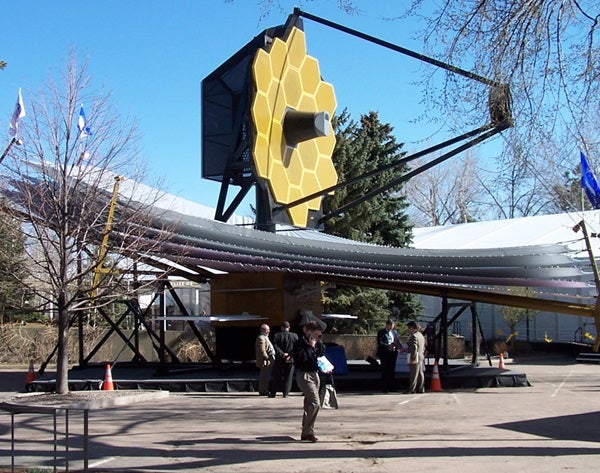A full-scale model of the James Webb Space Telescope (JWST) was on display in Orlando, Florida, where the International Society of Optical Engineering on Wednesday wrapped up its weeklong biannual conference. The telescope is an odd-looking contraption that would be more at home at one of the theme parks just down the road, but with just 7 years until launch, anxiety is rising among the team putting together the successor to the Hubble Space Telescope. This week, the second of the observatory’s 18 beryllium mirror segments arrived for polishing at a contractor’s laboratory in California.
In mid-June, the first finished segment will be taken for testing at NASA’s Marshall Space Flight Center in Huntsville, Alabama. It will be placed in a chamber and chilled to about –400° Fahrenheit (–243° Celsius), which is a bit colder than the telescope’s intended operational environment a million miles from Earth. The cold will ensure that the telescope can sense extremely faint radiation that otherwise would be masked by the Sun’s heat bouncing off of Earth.
From Alabama, the 1.3-meter hexagonal mirror heads back to Tinsley Laboratories’ facility in Richmond, California, for final touches. Polishing must be within 20 nanometers — 20 billionths of a meter — to perfection. This is what is needed to image objects so far away from Earth, they have slipped from outputting visible light and now radiate weakly in infrared wavelengths.
A healthy chunk of the project’s lifetime $4.5-billion budget is being spent up front to solve the many technical challenges, explains Rolf Danner with Northrop Grumman Space Technology, the telescope’s prime contractor. “We want to reach the phase where we put the technology together,” he says. “Then, we’ll have until 2013 to build and test and fly.”
The telescope’s most impressive feature is sheer size. At the observatory’s base is a five-layer Sun and micrometeorite shield that is as large as a tennis court. Perched above, panels fit together like flower petals to render the telescope’s 6.5-meter prime mirror. No launch vehicle is big enough to carry the telescope as is, so it’s designed to unfold in orbit, origami-style.
JWST is the crown jewel of NASA’s space-science program for the next decade. Its mission is to uncloak the invisible structures of the early universe. With a gold-coated primary mirror that is 7 times larger than Hubble’s, plus instruments sensitive to infrared radiation, JWST is intended to answer questions raised by Hubble’s galaxy-stuffed deep-field sky surveys. It will peer at what lies beyond.
“We’re going to stand on the shoulders of giants,” says NASA project scientist Mark Clampin, “and we’re going to continue the studies.”










